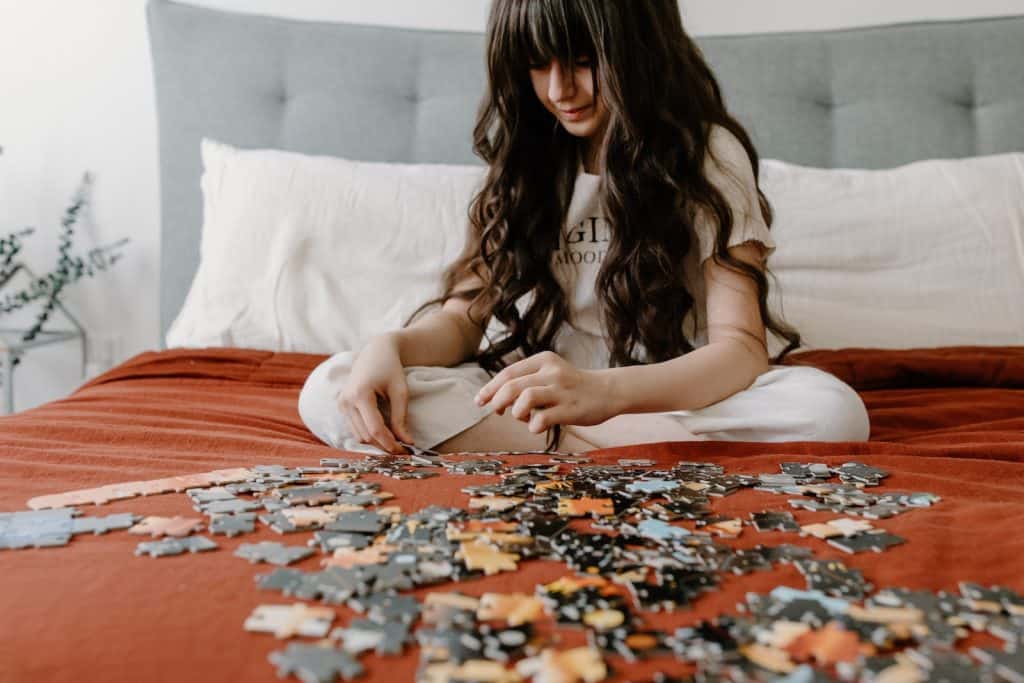Raising children provides critical opportunities to nurture and enhance important skills they require for their development and future success. Hand-eye coordination – a necessary ability for physical activities such as sports and interactive learning experiences – is one such skill. A popular subject of discussion is, does solving jigsaw puzzles improve hand-eye coordination? In this blog, we seek to explore the diverse benefits of jigsaw puzzles and provide insight into their potential impact on hand-eye coordination.
Understanding Jigsaw Puzzles
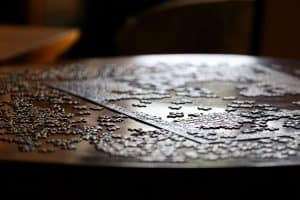
As early as the 18th century, jigsaw puzzles have been around, fascinating people of all ages with their unique challenge. These playful games present more than a simple activity to pass time—they have been known to offer cognitive, fine motor skills, and social benefits to both children and adults.
Jigsaw puzzles go beyond the joy of seeing a complete picture. They take players on a journey, starting from scattered pieces, through the process of trial and error, to the satisfaction of fitting the pieces together to form a complete image.
Not only are there different shapes and sizes of jigsaw puzzles, but they also offer various levels of complexity. It’s this variety that allows puzzles to cater to different individuals – from toddlers grappling with large, simple pieces to adults investing hours or even days into complex puzzles with thousands of pieces.
In essence, jigsaw puzzles cater for an extensive range of mental and physical requirements and are adaptable to a variety of skill levels – making them not just a fun pastime, but an important tool for development and learning across all ages.
How Hand-eye Coordination is Tested
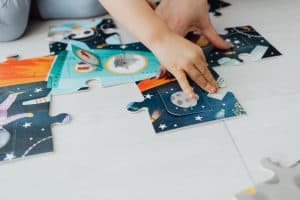
Understanding how to test hand-eye coordination starts by identifying activities that require us to use our visual perception and hands in unison. Activities such as threading a needle, drawing, or even playing a video game are prime examples of how this important skill is utilized.
These kinds of activities demand precision and, often, speed, both of which are key components of hand-eye coordination. As such, they serve as effective test cases for assessing hand-eye coordination levels.
It’s important to note that hand-eye coordination refinement is essential, no matter your age. Within children, it plays a crucial role in their motor skills development, while in adults, it can significantly impact everyday tasks and overall quality of life.
From writing and typing to cooking and driving, hand-eye coordination is a crucial component of our daily lives. Working on improving it can not only bring about a noticeable difference in how we conduct our routine tasks but also stimulate brain health, making it vital to maintaining a balanced daily life.
The Science Behind Jigsaw Puzzles and Hand-eye Coordination
Does solving jigsaw puzzles develop fine motor skills and improve hand-eye coordination? Researchers seem to be pointing to the affirmative. Surprising as it might seem, there’s a strong scientific establishment supporting this hypothesis.
One of the underlying mechanisms at play here is that when you sit down to solve a puzzle, your brain and eyes start working in unison. It’s not as simple an activity as it might appear on the surface. In reality, a mixture of cognitive skills are put to the test.
Your brain is engaged in a constant identification process, focusing on each piece and analyzing where it might fit in the larger picture. At the same time, your hand movements are guided by the visual perception your eye provides. This ongoing interchange between your visuals and hand movements is what works towards developing your hand-eye coordination.
Therefore, it’s clear to see by now how jigsaw puzzles help refined fine motor skills and enhance hand-eye coordination. So next time you sit with a puzzle in front of you, remember the added benefits it comes with; it’s not just a fun activity, but a continuous learning experience for your brain.
Detailed Discussion on How Jigsaw Puzzles Enhance Hand-eye Coordination
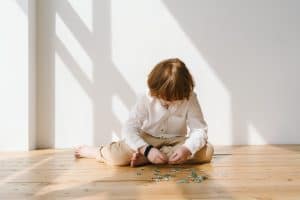
Jigsaw puzzles present a unique opportunity to work on hand-eye coordination. This process begins when you start resolving a puzzle. The coordination between what your eyes see, the brain comprehends, and how the hand responds is a significant part of the overall puzzle-solving process.
At a granular level, this involves your eyes scanning the various pieces and identifying potential matches. This visual data is processed in your brain, the central hub of information, where it is decoded, understood, and subsequently linked to a suitable action.
A crucial stage involves your hands, quickly directed by your brain to pick and select pieces based on the interpreted visual cues. This step often requires precise movements to ensure the selected piece fits correctly, further promoting fine motor skills.
The repeated picking, placing, and adjusting of the different puzzle pieces exercise the brain, training it to memorize these visual cues as well as to create the appropriate physical responses. As a result, this process promotes an improvement in overall eye coordination.
Moreover, problem-solving skills are enhanced by solving jigsaw puzzles. As you refine and re-evaluate your strategy to find the correct puzzle match, you exercise both your brain and your problem-solving abilities.
Therefore, the activity of working on a jigsaw puzzle can be genuinely viewed as a comprehensive workout for brain cells, leading to more improved hand-eye coordination and sharpening of problem-solving skills.
Puzzles for an Aging Brain
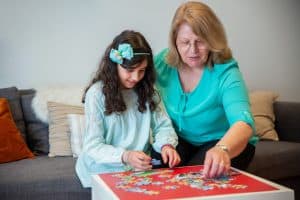
Engaging in puzzles regularly is beneficial for older adults as well. It is understood that puzzles can aid in maintaining mental agility and enhancing specific kinds of intelligence. These include areas such as crystallized intelligence and sustained attention.
Moreover, routine mental workouts can have profound effects on one’s brain health. This consistent cognitive exercise is suspected to potentially hinder the onset of dementia symptoms.
Case Studies and Real-life Testimonies
The belief that puzzles, specifically jigsaw puzzles, are beneficial for the development of children isn’t solely based on theory. There are numerous first-hand accounts and expert opinions that have significantly influenced this perspective.
These expert assessments and personal testimonials underscore an enhanced ability in problem-solving among children who regularly engage in puzzle-solving. They explore how these fun, shape-matching activities can stimulate the cognitive process needed to find solutions.
In addition to problem-solving, many of these studies have also observed improvements in short-term memory associated with puzzle-solving. As children attempt to recall the shape, color, and potential location of individual pieces, they sharpen their memory skills.
Furthermore, research and testimony emphasize the positive impact on a child’s self-esteem. Progressing from the first piece to the last, completing intricate images, and overcoming challenges instills confidence and self-assurance in a child. Puzzles, then, not only provide cognitive benefits but also contribute to a positive self-image.
Additional Benefits of Jigsaw Puzzles for Children
Jigsaw puzzles are not just advantageous to adults, but they offer numerous benefits to children throughout their development stages. The process of piecing together puzzles can have a tremendous impact on a child’s development, significantly influencing their education and life skills.

1. Enhancing Visual-Spatial Reasoning: This refers to a child’s ability to understand the spatial relationships among different shapes in a specific environment. Puzzles help children develop this skill by enabling them to manipulate different pieces in their environment to fit together to form a complete picture.
2. Teaching Goal-Setting Skills: The end goal in a jigsaw puzzle is completing the picture, aspiring children to work towards a visual, achievable goal. Starting with the border and then working their way in, puzzles can help children develop the ability to strategize and plan.
3. Improving Self-Esteem: Successfully solving a jigsaw puzzle, especially one that is complex, can significantly boost a child’s self-confidence and self-esteem. Overcoming the challenges involved in problem-solving through puzzles gives children a sense of achievement and pride.
4. Developing Social Skills: Puzzles can be done individually, as well as in a group allowing opportunities for social interaction and the development of teamwork skills. This fosters good communication and cooperation when children work together to complete the puzzle.
5. Providing an Opportune Learning Platform: While having fun, children also learn about different themes- nature, numbers, shapes, the human body, and more. Thus, puzzles can be a key educational tool that promotes and enhances learning in an early age.
Does Solving Jigsaw Puzzles Improve Hand-eye Coordination?
Can solving jigsaw puzzles improve hand eye coordination? Yes, they can and do! But that’s not all – they’re also great for boosting your brain health, decreasing stress levels, building your short-term memory, and even improving your patience and critical thinking. So the next time you sit down to complete a puzzle, know that you’re building a big picture far beyond the game itself, in your own mind and in your developmental skills too.
So do jigsaw puzzles help in improving hand-eye coordination and other cognitive abilities? The answer is a resounding yes.
Conclusively, whether you’re a parent seeking ways to aid your child’s development or an adult looking to keep your brain active, mastering a jigsaw puzzle has many benefits, both cognitive and otherwise, to offer. Apart from being a fun way to pass your time, puzzles also provide critical thinking training, helping you and your children learn and solve problems effectively, and perhaps, more importantly, have a great time doing it.

